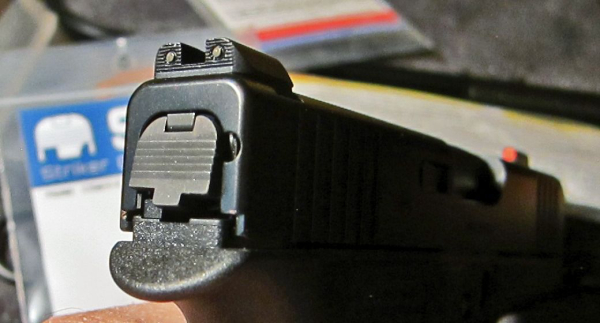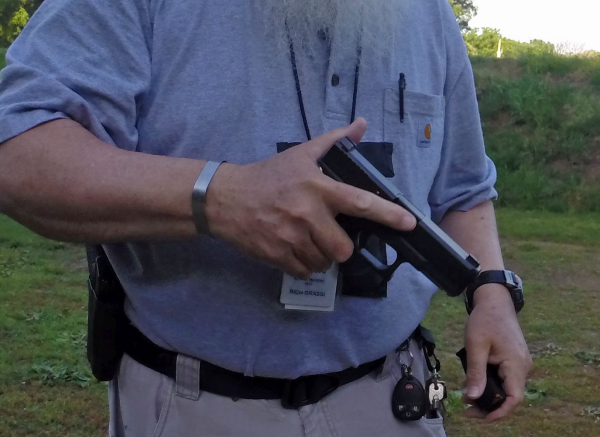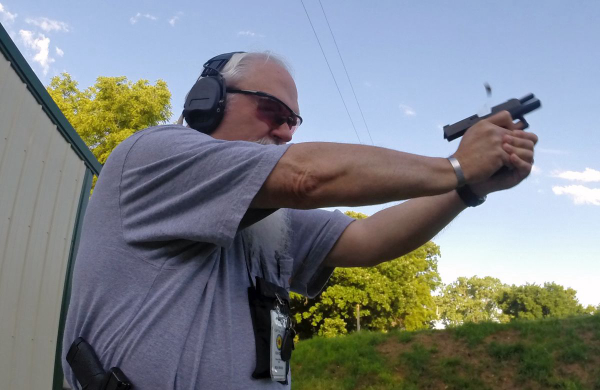I occasionally get asked to look at gear. If it’s something that appeals to me, I accept -- as I did in this case. The item is something I considered useful for constant carry to provide illumination assistance in navigation yet has more power than a regular ‘keychain’ light for those rare circumstances where I have to see further. An additional perk would be not having to replace batteries regularly – a rechargeable light.
On a keychain?

Enter the Fenix E05R rechargeable mini flashlight. With up to 400 lumens and 64 meters maximum beam distance, it’s quite powerful. Starting out at three lumens, enough to find the keyway to unlock a door at night or to look through your unlit safe, the medium setting – 25 lumens – is enough for reading a menu in a dimly-lit restaurant or for typical navigation chores, preventing you from stepping in something.
The rechargeable aspect of this solid aluminum body flashlight is accomplished through a micro-USB port. Hidden, the port is exposed by simply twisting the barrel of the light down until the port appears – right below the switch.

The switch is a single button on the side just behind the LED head. It is raised. As the circular ring around the light is cut with flats to keep the light barrel still if you have it set upon a desktop, say, there’s the raised area around the switch that you can feel – it’s hard to see the switch in the dark.
Hanging it around my neck on the lanyard isn’t the most ‘tactically sound’ way to carry the light, but at just over 2 ½” long and weighing in at less than an ounce, it’s not a duty light but a utility light.
To get the full power “burst” mode of 400 lumens – which I expect to seldom need – takes a “press and hold.” It reduces to a lower level before another press shuts it off.
Priced very reasonably, it prevents the “do you have a flashlight?” query because there’s no excuse for not having a light available at all times. And, as their promo video mentions, you can save the power of your mobile phone for communications – and not use it for a flashlight.
It ships with a micro-USB charging cable, key ring, spare O-rings, a user manual and a warranty card.
I find it very handy and quite useful – as a light should be.
Adding to the ‘gear’ discussion, I was happy to see that Langdon Tactical is now producing “The Gadget,” properly called the Striker Control Device. I was unaware that Tau Development had ceased production of the device and it should be available from LTT soon.

Now called the LTT Striker Control Device (SCD), it’s the same thing I wrote about in the summer of 2020 – and I’m glad I got mine while the ‘getting was good.’ What is it and what does it do?
The idea was simple. The well-trained protocol for safe holstering of a handgun involved placing the thumb of the shooting hand over the hammer of the pistol or revolver. This could be done in such a way to prevent hammer travel if something snagged the trigger during the reholstering process.
Doing this works on various hammer-fired guns. What do we do about striker-fired guns?
The “gadget” was far simpler than the various safety elements of hammer-fired guns; so simple that the original pistol’s designers had to have kicked themselves when they saw how easy it is. It replaces the OEM striker cover plate, that piece that keeps the striker in the slide, as well as provides pressure to the extractor depressor plunger via the spring-loaded bearing.


The “striker control device” simply blocks movement of the striker rearward – required to get the requisite distance before getting enough tension and distance to be released – preventing firing.
It’s not a ‘safety’ as such; it simply prevents firing of the gun if pressure is placed on the back of the slide. One still needs to mind the muzzle and stay clear of the trigger. The SCD is a passive device. In normal operation, it does nothing.
According to Langdon’s website, “The LTT SCD works with all of the Gen 5 Glock pistols. We have SCD’s in production for slim frame guns (43, 43X and the 48) – please add your name to the wishlist to be notified when they are in stock.”
As Caleb Giddings on the Tactical Life site noted, “The SCD isn’t a replacement for safe gun handling. You should always re-holster cautiously and thoughtfully. Holstering a loaded gun is probably the most dangerous thing you’ll do all day, so it makes sense to do it carefully.”
That’s very sensible – especially in the aftermath of a confrontation that had the potential – let alone actual employment – of deadly force. I know everyone says “look the gun into the holster.” That works in “range world” or during dry practice. Operationally, in adverse lighting conditions, in foul weather, with an elevated heart rate and BP, with people moving around and your ears ringing and you know the constabulary is likely enroute … it pays to have a bit of redundant safety.
It’s designed to work with OEM GLOCK triggers and aftermarket trigger components that do not alter pre-travel compared to the stock trigger – don’t install the Striker Control Device on any gun with aftermarket triggers that reduce pre-travel.
I Installed the SCD on three guns that are the most likely carried GLOCK pistols available to me: a Gen5 G19 that was from the rollout of the line in August, 2017, a GLOCK 43 and a G43X. That’s been two years ago. At first, the flapping slide cover plate/SCD was quite noticeable – but that goes away.
It’s smart money. If you carry a Gen5 GLOCK – or a slim frame GLOCK – this is a recommended component.
-- Rich Grassi